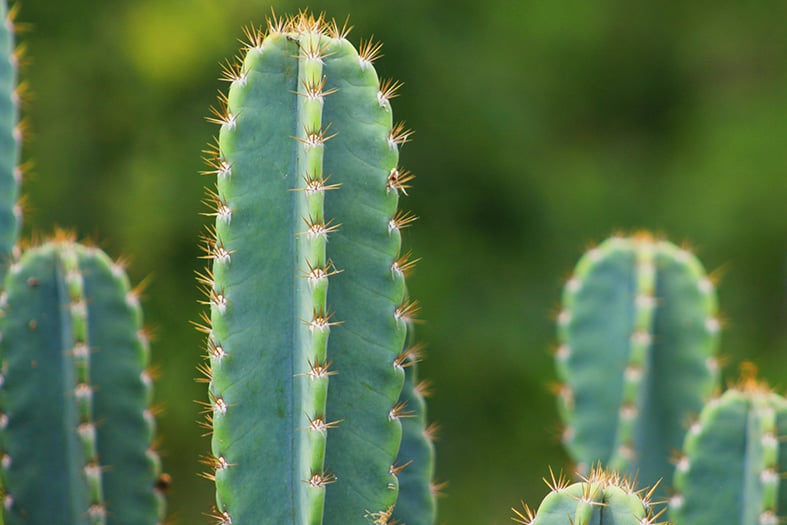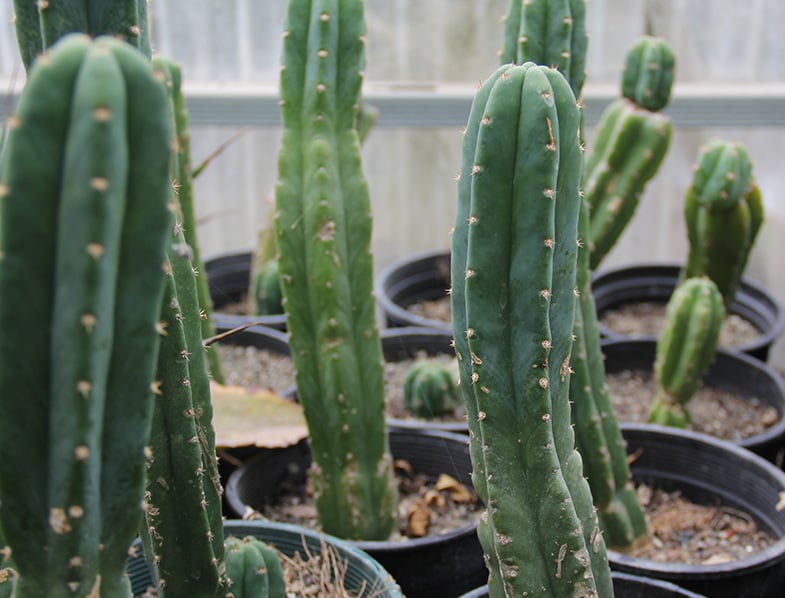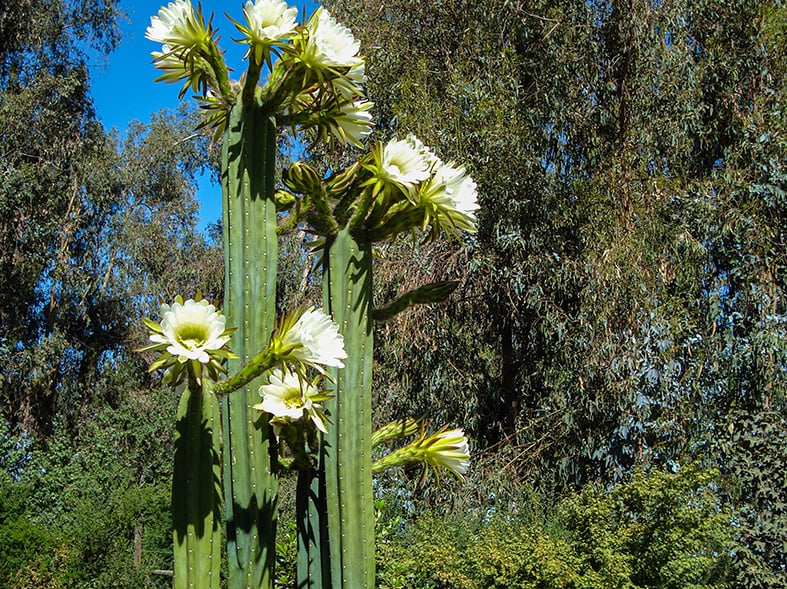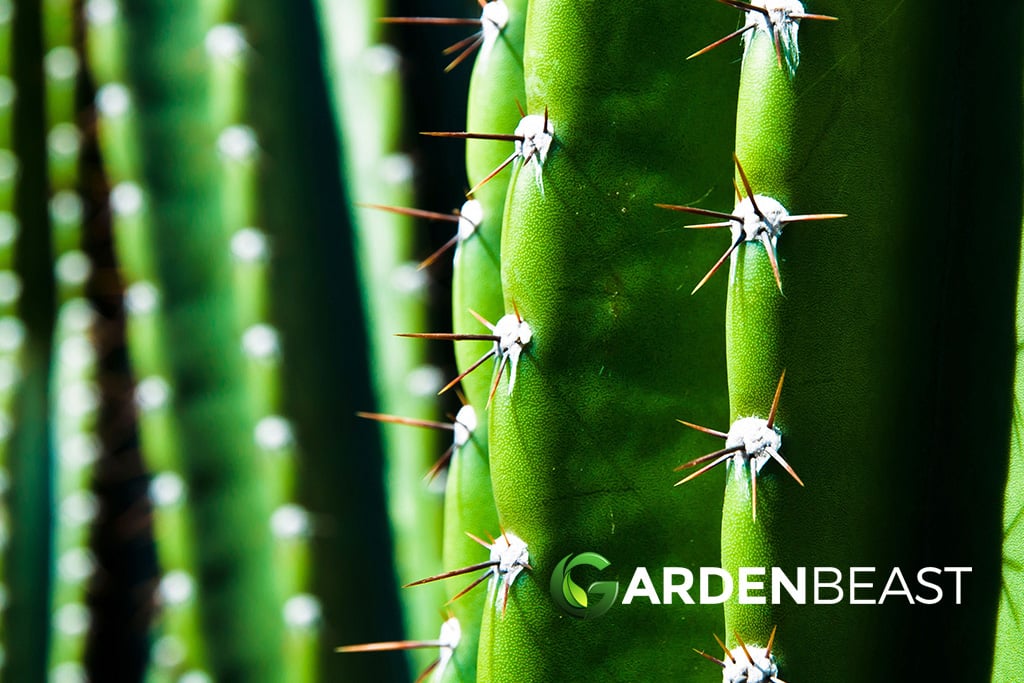Echinopsis Pachanoi, also known as Trichocereus Pachanoi, Achuma, Cactus of the Four Winds, or the San Pedro Cactus, is a very easy-to-grow and popular columnar cactus.
Natively found in South American countries like Peru, Chile, Bolivia, and Ecuador but grown in other parts of the world as well, this impressive cactus is quite fast-growing and it can reach up to 20 feet (3m) in height.
This ornamental cactus has been used for thousands of years in traditional medicine and shamanic rituals in South America so it comes as no surprise that it has over 25 different names such as andachuma, huachuma, achuma, aguacolla, giganton, hahuacollay, to name a few.
Cataloged by Dr. Joseph Nelson Rose, an American botanist, who named it after Eng. Abelardo Pachano Lalana, a renowned Ecuadorian botanist, Echinopsis Pachanoi is full of surprises. It contains mescaline, a controversial psychedelic which is illegal in the US, where the plant is sold solely for ornamental purposes.
Growing, caring for and propagating Echinopsis Pachanoi is fun and rewarding, for beginners and experienced cacti growers alike. The San Pedro cactus thrives at high altitudes, such as the Andes Mountains, where it can be found at altitudes of 6,600–9,800 feet (2000-3000m).
When grown outdoors, the San Pedro cactus can withstand temperatures as low as 48.2°F (-9°C) and it prefers temperate climates, plenty of light, and fertile, well-draining soil.
About Echinopsis Pachanoi
- Echinopsis Pachanoi, also known as the San Pedro cactus is native to Peru, Ecuador, Argentina, Chile, and Bolivia and it thrives at high altitudes, in the Andes Mountains.
- It can be grown outdoors in USDA Hardiness Zones 8b to 10b as it doesn’t mind cooler temperatures as long as they don’t drop below 15°F (-9°C).
- San Pedro cacti need a lot of natural light and mature plants don’t mind being in full sun. Seedlings, however, are a bit more sensitive and can suffer sunburn.
- When grown indoors, these cacti need well-draining soil and if they cannot get enough natural light you might have to invest in some grow lights.
- Like all cacti, Echinopsis Pachanoi loves light and warmth. However, this cactus prefers soil that’s a little more nutrient-rich than regular cacti soil mix.
- Natively-found at high altitudes, this cactus might require more water, especially on hot summer days.
- It is a fast-growing cactus that’s been used in South American traditional medicine and religious rituals for centuries. Like Peyote, Echinopsis Pachanoi contains mescaline, an illegal psychedelic similar to MDMA.
- While consuming San Pedro cacti is illegal in most countries, growing it is not, so it’s perfectly safe to decorate your home or garden with these amazing plants.
- The Echinopsis Pachanoi is moderately poisonous so you should keep is within a safe distance from children and pets.

Echinopsis Pachanoi Features: An Overview
- The San Pedro cactus, is a large columnar cactus that grows relatively fast. Depending on their growth environment, San Pedro cacti can grow up to 12 inches (30 cm) per year.
- This multi-stemmed cactus can reach up to 19 feet (5-6 meters) in height and 6 feet (2 meters) in width.
- The thick individual stems of the Echinopsis Pachanoi are green or blue-green and they become darker with age. They have between 4-8 ribs each and can be 2.4-5.9 inches (6-15cm) thick.
- In July, the pointy buds of the San Pedro cactus produce beautiful whitish flowers which open at night, have a pleasant fragrance, and measure approximately 8.7 inches (22 cm) in diameter.
- The edible fruits of the Echinopsis Pachanoi are called Pitahaya and are red-skinned, scented, sweet, and tasty.
- It is closely related to Trichocereus peruvianus aka the Peruvian Torch Cactus. In fact, these two cacti are so similar that their names have become interchangeable and it’s pretty much impossible to tell them apart if you’re not a specialist.
- Echinopsis Pachanoi cacti pair well with Senecio mandraliscae, Aloe cameronii, Phormium tenax, and Agave truncata.

Growing Echinopsis Pachanoi
Growing Echinopsis Pachanoi is easy especially since this versatile cactus is very forgiving and only needs a little water and some nutrients. The best thing about San Pedros is that they don’t mind cold weather as long as the temperatures don’t drop below 15°F (-9°C). So, if you live in a temperate region, you won’t have any issues with growing San Pedro cacti outdoors.
In its natural habitat, this cactus gets a lot of natural light and its soil is more nutrient-rich than the regular cacti soil mix. If you grow this cactus in a container, you can feed the soil a little, but not too much, because it’s still a cactus.
Cacti don’t need a lot of water to grow healthy and happy, but just like any other plant, they do need some care, love, and attention. When growing Echinopsis Pachanoi indoors, make sure you place it on a well-lit window sill, preferably on the south-side, and water it more often on hot summer days.
- SMART NUTRIENT BALANCE: Carefully crafted with succulents and cacti in mind, this specialized blend provides the perfect nutrient balance for optimal growth
- ENHANCED SOIL STRUCTURE: The inclusion of aged bark promotes a better soil structure, enhancing aeration and root growth for stronger, more resilient plants
- RAPID DRAINAGE SYSTEM: The incorporation of perlite and horticultural sand facilitates fast drainage, preventing waterlogged soil and safeguarding your plants from root rot
- SMART GARDENER'S CHOICE: Designed exclusively for succulents and cacti, this smart soil mix takes the guesswork out of plant care, giving your green friends the best environment to flourish
- 100% SATISFACTION GUARANTEE: Our USA-made product comes with a 100% growth guarantee, and if you're unsatisfied, we'll promptly send you a Back To The Roots replacement upon messaging us
Last update on 2024-10-16 / Affiliate links / Images from Amazon Product Advertising API
As mentioned above, these cacti grow relatively fast, especially if they are acclimatized to their growth environment, they are planted in good soil and watered more often throughout the warm summer months. Mature, established plants can grow 11-12 inches (30cm) in a year.
Echinopsis Pachanoi cacti are quite susceptible to fungal infections such as witches broom disease and orange rot, especially when they are overwatered. If you suspect that your cactus has a fungal infection, make sure you remove all the affected parts with a clean knife.
If the plant has too many lesions, it might be better to take a few healthy cuttings and start a new plant. In general, fungal outbreaks can be prevented if the cactus has well-drained soil, plenty of heat, proper ventilation, and a sterile medium.
Other common pests that can affect Echinopsis Pachanoi include scale, spider mites, and root mealybugs all of which can be easily removed with neem oil or simply scrubbed off if the plant isn’t severely affected.

Watering Echinopsis Pachanoi
San Pedro cacti prefer a dry environment and, like most cacti, they are very sensitive to overwatering, which is the number one cause of cacti demise. Because they naturally grow in the Andes Mountains, at high altitudes, San Pedro cacti thrive in temperate environments, so if you live in USDA Hardiness Zones 8b-10b, you can grow these beautiful ornamental plants outdoors.
When planted outdoors, San Pedro cacti will need more frequent watering in summer, and minimal watering in the cold winter months. Cold temperatures can prevent the water from evaporating, and your cacti might sit in damp soil for too long. This, in turn, can lead to root rot, which must be avoided at all costs.
A major difference between Echnopsis Pachanoi and other cacti is the fact that it requires some nutrients from time to time. You can purchase specific cacti nutrition that has high amounts of phosphorus and potassium, and low amounts of nitrogen. The ideal NPK value for cacti fertilizer is 4-7-7 and 2-7-7.
Propagating Echinopsis Pachanoi
You can easily propagate Echinopsis Pachanoi cacti from offsets, which grow abundantly around the base of the mature plants.
- To remove the offsets safely, make a clear cut with a sharp, clean knife as close to the stem as you can.
- Place the fresh cutting on a piece of paper and let it dry out a little, cut it at the narrowest place possible, and let it callous for a few days.
- Once the cutting has calloused, you can safely place it in a container with drainage holes and well-draining soil.
If you plan on repotting your Echinopsis Pachanoi, it’s best to do it during the warm season. Before repotting, the soil should be dry to prevent damaging the roots. Remove as much soil as possible and clean any rotten or dead roots in the process.
Keep an eye out for pests and diseases and treat any cuts with a fungicide. Put the plant in its new container and spread the roots as much as possible while adding fresh cacti soil mix. Let the plant rest in dry soil for a week and then start watering it lightly until the plant adjusts to its new environment.
Echinopsis have stiff spines, so you might want to wear gloves while handling these plants.
In Conclusion
Growing Echinopsis Pachanoi is fun and rewarding because these friendly giants grow faster than other cacti and they produce beautiful flowers and edible fruit. To grow healthy and happy, they need well-draining soil, plenty of natural light, and a little water once in a while. You can grow them outdoors if you live in a temperate region, as long as the winters are not extremely cold.
Echinopsis Pachanoi cacti make amazing ornamental plants, but they are also rich in mescaline, a psychedelic substance, so consuming these plants is illegal in many countries.
Growing them as ornamental plants, however, is perfectly safe, but you should still keep them away from children and pets.


10 Comments
Is this plant, and or its flower droppings toxic to dogs?
Hi! The San Pedro Cactus is rich in Mescaline so it should be kept away from children and pets. If you’re worried about something your dog ate, it’s best to take him to the vet.
I wouldn’t worry about someone eating this without intention..and if I would be a dog, a drive to the vet sounds like an absolute horror trip!
If your dog ate it still, take care of a nice setting, toys around, some calm sitar music, a blanket, strokes and let him hear your voice if he seems scared 😉
I’ll hope to get mine flowering this year! Also got one crystata variation which I like very much.
Nice blog!
Thank’s and Regards
It’s always better to be safe than sorry 😀 Good luck getting yours to flower!
We’re happy you enjoyed our article! Stay tuned for more interesting articles about other amazing plants and useful gardening equipment 😉
Hello –
I have a very tall Echinopsis Pachanoi, and it has sections where a light colored circular ring like discoloration is prevalent all over about a foot of the cactus. I don’t know if this is a fungus? Or what else it might be. Can you help me identify it?
Hello!
It is a bit difficult to identify your issue without seeing a picture of your cactus, but in most cases, discoloration happens because of too much moisture, freezing temperatures, and excessive fertilization. Root rot is a very common issue among cactus growers and saving a plant that’s severely affected is pretty much impossible.
If you’re not dealing with root rot and you suspect that it’s a fungus or a viral infection, it’s best to contact a cactus expert in your area so that they can take a look at your plant.
Wishing you the best of luck,
Miruna
I have one of these cactus, it’s about three years old and about three foot tall. It’s about 2” at the bottom and about 3/4 at the top. It has started to bend over and I have had to brace it up. Anything I can do to straighten it up and thicken the diameter so it is more stable.
Besides spears(thorns) they taste terrible I don’t think anyone needs to worry about dogs or children eating it.
I had one in a pot and our rotweiler puppy dog started chewing it. He was fine though i didnt need to take him to the vet.
Ballzanisland dressing is a good fertilizer for my cactus.